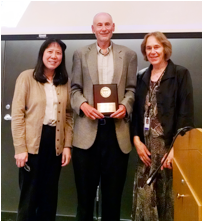After a very special day with friends and colleagues last week, Lagakos Distinguished Alumni Awardee Victor DeGruttola chats with post-doctoral fellows Laura Balzer and Melanie Prague about his career in the Department.
 Melanie: Can you share with us your favorite memory about Steve Lagakos?
Melanie: Can you share with us your favorite memory about Steve Lagakos?
Victor: I have two: One of a cook-out at his house in Wellesley during the summer of 1985, where we had our first in-depth conversation about the statistical challenges that arose in trying to make sense of data on the AIDS epidemic; the HIV Working Group was born in this discussion. The second was the time that he picked up me and my bicycle in Bellow’s Falls, VT after I had biked up to Montreal from Boston and then back down through Vermont. I spent that evening and the next day NH with Steve, Regina, David and Adrian in Hancock, NH, swimming, boating, and eating sister Pat’s spanakopita. Their fun-loving hospitality was beyond anything I had ever experienced.
Melanie: You seem to be a good biker. Can you tell us more about you, do you have hobbies or hidden skills? What do you enjoy doing during free time?
Victor: I am more the tortoise than the hare, but I do like the speed at which the scenery goes by while biking. My favorite thing to do is bike to a lake, swim across it and bike home—great for clearing my lungs and my head. No hidden skills unfortunately, but I still remember the guitar chords I learned when I was 15 (not much progress there).
Laura: What is your favorite part of your job as Professor of Biostatistics?
Victor: I think all of the faculty would agree that the best part of our job is working with students and post-docs to help them develop their skills, refine their interests, and get launched on careers. And this gets better over time as you see your former students take on leadership roles and sometimes continue with research areas they started during their time at HSPH.
Laura: What advice would you give to new Post-Docs and junior faculty?
Victor: Decide for yourself what is important in your lives and careers. Don’t focus your efforts on what appears to be the most marketable research area if your heart isn’t in it. Your senior colleagues can be a great source of support for the plunge into independent research—but this support should be for the pursuit of your own goals, not theirs. Being independent is riskier than staying in a junior role—even those who have made great contributions don’t always succeed right away. But I believe that finding fulfillment in the process of doing science—or art—depends on developing an original synthesis of available modes of thought and expression—through which you can communicate your own view of some aspect of life and the world.
Laura: Many of us (myself included) struggle with finding the optimal work-life balance. Can we really ‘have it all?’
Victor: I can’t imagine how one really could, but Steve certainly showed us that one life can cover a lot of ground! The main message that I have learned from life is a cliché: follow your passions—not only those related to career. For me, and I think for many of us, the Dept. of Biostatistics has helped make that possible.
Melanie: Having good ideas seems to be the main but most challenging aspect of being a good researcher. You often say that “randomization is not the key to everything”, what are innovative future directions in the agenda of testing HIV prevention policies?
Victor: I believe that we need to develop more methods/approaches intended to assess progress in achieving goals, for example to make HIV unsustainable in populations, rather than just to compare interventions—for which randomized experiments are particularly well suited. Observational studies generally allow more flexibility in responding to real-time information that helps guide deployment of resources. This feature may make them well suited to studying the effect of implementing combinations of proven therapies to achieve a public health goal. To do so will require advances in quantitative methods, such as causal methods for highly dependent data from epidemic settings, as well as improved ways to merge databases that contain very different sources of information, including that from viral genetic sequences, surveillance, behavioral surveys, and clinic data. Such methods will help in monitoring the impact of interventions on an epidemic and directing real-time mid-course corrections to enhance it.



